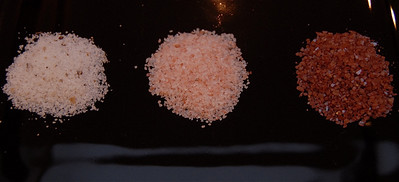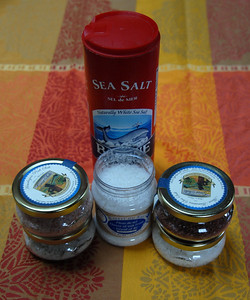One of the essential minerals and oldest seasonings has gone gourmet. Forget about the white, fine-grain, mass-produced salt crystals of the past. Chunky sea salts in hues of beige, pink, red and black have taken over kitchens, tabletops and gourmet grocery aisles around the globe. Prized by chefs, connoisseurs and home cooks, they come from France and the Mediterranean coast, from salt pans in Tunisia and Majorca and from countless other sites, including Hawaii, Australia and Bali.

In the Mediterranean sea salt is produced by an age-old technique. Here sea water is collected in shallow basins and allowed to evaporate in the sun. As it dries up, salt forms at the base of the pans. There it takes on the color of the clay or other natural materials found on the bottom. The salt at the top remains pure white. In France this delicate salt is known as fleur de sel. Light tasting and quick dissolving, it’s primarily used to finish dishes but it occasionally appears in baked goods.
What do cooks do with all these different salts? As with fleur de sel, many use them to finish off a dish, enhancing the flavors and appearance of the prepared food. Himalayan pink, Hawaiian black lava, smoked and flavored salts all perform this role. When used sparingly, the salts pump up the taste profiles and add a dash of color and texture to vegetables, fruit, fish, meat and poultry. Spread with a heavy hand, they will overwhelm the natural flavors and leave diners with a briny aftertaste. That no cook wants to do.
In my home sea salt has replaced the usual iodized salt. Need to salt boiling water? I reach for my container of coarse sea salt. Want to bring out the sweetness of a particular fruit? I shake a little fleur de sel over the top. Looking to spice up broiled cod filets or grilled tuna steaks? I sprinkle on a smidgen of black truffle or lime smoked salt. As with any seasoning, a little goes a long way.

Because I don’t live in a particularly damp climate and use a salt mill rather than a shaker, I’m not too concerned about my stash of sea salt clumping. This was one of the original selling points of mass-produced table salt. As one company slogan put it, “When it rains, it pours.” Likewise, I already receive an adequate amount of iodine in my diet. Why add more? I do, however, want to add a little excitement to my dishes and keep my foods as natural as possible. That’s why I’ve joined the masses and opted for sea salts.
CRAB CEVICHE
Recipe courtesy of the gourmet salt purveyor Great Salts
10 oz. fresh crab meat
2 large fresh chopped tomatoes
4 tablespoons finely chopped cilantro
1 garlic clove finely chopped
1 diced green bell pepper
1 diced green chili (optional if you like spicy food)
1.5 oz. fresh squeezed lemon juice
1.5 oz. fresh squeezed lime juice
Great Salts Bali Coconut and Lime Salt
Carefully mix all the ingredients in a large bowl (preferably glass) and allow to marinate in the refrigerator for at least one hour. Remove from the refrigerator and salt to taste using Great Salts Bali Coconut and Lime Salt before serving.